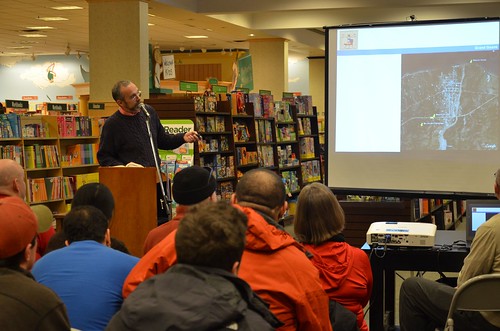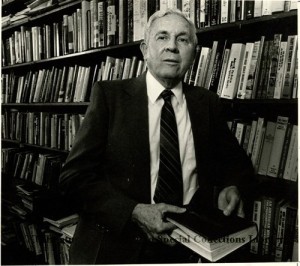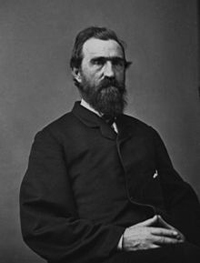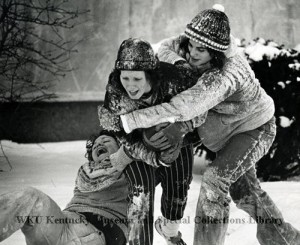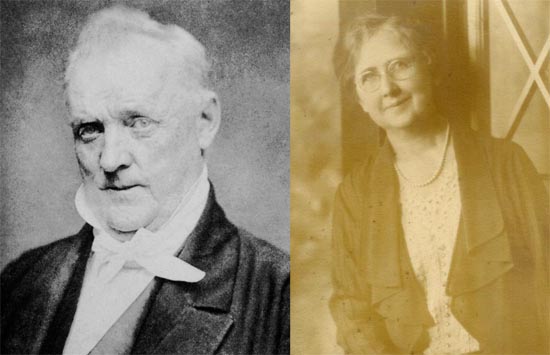Paul E. Fallon, an architect from Massachusetts who specializes in healthcare design, gave a presentation on his architectural design experience in Haiti, an earthquake-prone country in Central America, to an audience mostly of WKU students of architecture at Barnes & Noble on February 19, 2015. The presentation was part of the WKU Libraries’ “Far Away Places” speaker series.
Architecture by Moonlight: Rebuilding Haiti, Redrafting a Life
Comments Off on Architecture by Moonlight: Rebuilding Haiti, Redrafting a Life
Filed under Uncategorized
The NAACP in Bowling Green
On this day (February 12) in 1909, a group of activists in New York decided to reinvigorate African Americans’ post-Reconstruction quest for civil and political rights by forming the National Association for the Advancement of Colored People. Exactly a decade later, the Bowling Green, Kentucky branch of the NAACP was organized. At a mass meeting at the Cumberland Presbyterian Church, after hearing the urgings of various speakers on “the good that can result from same,” the first 37 members enrolled.
The Manuscripts & Folklife Archives holdings of WKU’s Special Collections Library include copies of the membership lists and minutes of the Bowling Green NAACP from its inception to June 1927. Meetings, which rotated through the churches of the city, featured music, prayer, speakers, and discussions of local issues affecting African Americans. For example, at an executive meeting in March 1919, the problems of “unequal accommodations for our race in traveling,” the “unsanitary conditions existing in the colored Waiting Room at the [train] depot,” and “The Need of a lunch stand for our Race at the depot” were referred to a committee on grievances for follow-up with the proper authorities. In May, a clergyman “spoke of indignities heaped upon our people by arresting them on suspicion and when proven guiltless nothing done to exonerate the suspect.”
The chapter also considered issues brought to its attention in press releases from the national organization. At a meeting in June 1921, local churches were asked to take special offerings for the “stricken & suffering” victims of a destructive race riot in Tulsa, Oklahoma, and in October 1922 the executive resolved to collect funds to support the NAACP’s advocacy of a federal anti-lynching law.
Click here for a finding aid to the NAACP (Bowling Green Chapter) Collection. For more collections on African Americans in Kentucky, search TopSCHOLAR and KenCat.
Comments Off on The NAACP in Bowling Green
Filed under Manuscripts & Folklife Archives
Dr. Lowell H. Harrison exhibit and painting unveiling
The career of Dr. Lowell H. Harrison, faculty emeritus, Department of History, WKU, is being celebrated with an exhibit which opened on Wednesday, February 3, 2015, in the Harrison-Baird Reading Room of Library Special Collections at the Kentucky Building. Utilizing artifacts, photographs, and manuscripts, the case highlights his national reputation as a scholar, educator, WKU faculty member, and public speaker.
On Monday, February 9th at 3:30 p.m., a portrait of Dr. Harrison will be unveiled which will hang permanently in the Harrison-Baird Reading Room. Artist Nancy Disher Baird, faculty emeritus, Department of Library Special Collections, will make brief remarks. The public is invited to celebrate with us.
The case exhibit will close on February 11, 2015.
Comments Off on Dr. Lowell H. Harrison exhibit and painting unveiling
Filed under Uncategorized
Measles: The Sounds and the Silence
Measles “attacked every part of our camp at once,” wrote John W. Tuttle, a native of Wayne County who served with the Third Kentucky Infantry during the Civil War. In 1861, while at Camp Robinson near Danville, he noted the deaths of 61 soldiers and the suffering of countless others. It “settled upon the lungs of hundreds, perhaps thousands, and more or less seriously impaired their constitutions.” The effects were so debilitating that “at times, the spasmodic coughing” of the sick, especially in the cold, rainy autumn weather, made it “almost impossible” to hear orders during drills and parades. Their commander, Colonel Thomas E. Bramlette, was so irritated by the cacophony of his non-immune troops, remembered Tuttle, that he once “severely reprimanded the men of his regiment for not having had the measles when they were children.”
In Breckinridge County toward the end of the war, Bevie Cain saw a different side effect of the illness. “We are just recovering from a long round of the measles which has been in our family for nearly three weeks!” she wrote a friend. “I have escaped thus far, though I am grieved that they have so sadly afflicted my brother, who is almost deaf.” While out hunting near a road, the boy failed to respond when some passing soldiers called out to him. “I do not know what the consequence would have been,” Bevie wrote, “if a friend of his . . . had not come to his assistance, and informed them of his misfortune.” The proud young woman, an unrepentant Confederate sympathizer, mourned her brother’s condition. “Oh! I don’t know how I could bear the thought of his remaining thus all his life.”
These accounts of the measles are part of the Manuscripts & Folklife Archives holdings of WKU’s Department of Library Special Collections. Click on the links to access finding aids. For other collections documenting Kentuckians’ battles with contagious diseases, search TopSCHOLAR and KenCat.
Comments Off on Measles: The Sounds and the Silence
Filed under Manuscripts & Folklife Archives
Pet Rattlesnake, Heartbroken, Dies
The Biology Department is mourning the loss of its pet rattlesnake. Death came stealing in on Sunday night after Homecoming and claimed it for her own. Some seem to think that the rattler was so disappointed over Western’s loss to Murray that it felt that future life was not worth while, even if that life was to be devoted to science.
None of the other depart[ments] was affected, as no one but Death and the Biology Department would want a rattlesnake or care what became of it.
Yes, we are digitizing more College Heights Heralds. I do enjoy reading through them and coming across tidbits like the one above from the Nov. 10, 1933 issue. The October 27th issue had reported the 20 to 6 homecoming game rout. Apparently it was too much for a devoted Hilltopper rattle snake to take.
The latest issues to be digitized are 1933-1941, 2005 & 2006. Check them out in TopScholar – search by date.
Comments Off on Pet Rattlesnake, Heartbroken, Dies
Filed under University Archives
WKU Archives YouTube Channel
This is just one of the many 2-inch quadruplex videotapes housed in WKU  Archives. These tapes were first created for use in television production in 1956. Quads were phased out in the early-1980s and replaced by smaller videotapes. WKU no longer owns playback equipment for these tapes.
Archives. These tapes were first created for use in television production in 1956. Quads were phased out in the early-1980s and replaced by smaller videotapes. WKU no longer owns playback equipment for these tapes.
WKYU-TV recorded many programs using quad tapes that are being digitized through a $7500.00 WKU Libraries grant. In September 59 quad tapes were shipped to Transfer Media in Indianapolis for digitization to DVD. The second shipment of DVDs arrived at the Kentucky Building last week.
Theses titles are now available to researchers, some are now available on YouTube:
BRADD Legislative Report Senator Walter “Dee” Huddleston, 4/15/1977, CD884, Senator Huddleston reporting on legislative activities impacting the Barren River Area Development District
B-Roll of Chemistry Department & Various Campus Locations, 2/24/1971, CD894, a student conducting experiments in a chemistry lab and video of campus showing buildings on campus including Downing University Center
Comments Off on WKU Archives YouTube Channel
Filed under University Archives
January Out of the Box
Comments Off on January Out of the Box
Filed under University Archives
Kentucky Cave Wars
Since the first tourist tract written by Alexander Clark Bullitt in 1844, it seemed everyone wanted to visit the “Mammoth Cave.” He considered such a visit an almost spiritual pilgrimage. “Awe and apprehension soon yield to the influence of the delicious air; and after a time a certain jocund feeling is found mingled with the deepest impressions of sublimity. I recommend all broken-hearted lovers and dyspeptic dandies to carry their complaints to the Mammoth Cave, where they will undoubtedly find themselves ‘translated’ into very buxom and happy persons.”
Mammoth Cave is the country’s 26th national park and contains almost 60,000 acres of land in South Central, KY. But, the entire region, because of our 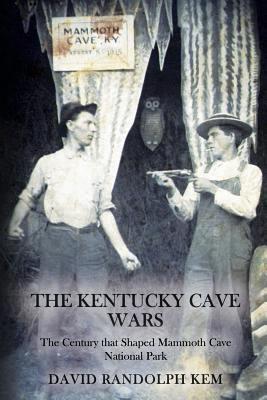 karst topography is riddled with caves. This push for visitors lead to one of the most interesting parts of Mammoth Cave history. It was the period known as the “Kentucky Cave Wars.” It was a time when local cave owners used devious advertising and other illegal means to lure tourists to their underground treasures and away from the “real” cave. They did this impersonating rangers and flagging travelers off the road before they could reach the cave and national park. A recent book by David Kem, The Kentucky Cave Wars: The Century That Shaped Mammoth Cave National Park, delves into this time by “telling the story of Mammoth Cave’s greatest competitors in the late nineteenth and early twentieth centuries. From the death of Dr. Croghan and the first competitors popping up in Cave Country, to the national park’s creation and beyond, more than a century of fighting for tourist dollars shaped the decisions in and around the famous cave.” Kem used several photographs and other illustrative materials from the Kentucky Library Research Collections to illustrate his new book. Find materials about the cave and other subjects in the Department of Library Special Collections by searching TopSCHOLAR and KenCat or request more information from spcol@wku.edu.
karst topography is riddled with caves. This push for visitors lead to one of the most interesting parts of Mammoth Cave history. It was the period known as the “Kentucky Cave Wars.” It was a time when local cave owners used devious advertising and other illegal means to lure tourists to their underground treasures and away from the “real” cave. They did this impersonating rangers and flagging travelers off the road before they could reach the cave and national park. A recent book by David Kem, The Kentucky Cave Wars: The Century That Shaped Mammoth Cave National Park, delves into this time by “telling the story of Mammoth Cave’s greatest competitors in the late nineteenth and early twentieth centuries. From the death of Dr. Croghan and the first competitors popping up in Cave Country, to the national park’s creation and beyond, more than a century of fighting for tourist dollars shaped the decisions in and around the famous cave.” Kem used several photographs and other illustrative materials from the Kentucky Library Research Collections to illustrate his new book. Find materials about the cave and other subjects in the Department of Library Special Collections by searching TopSCHOLAR and KenCat or request more information from spcol@wku.edu.
Comments Off on Kentucky Cave Wars
Filed under General, Uncategorized
The Buchanan Heirs
Like those e-mails we get today from Nigerian princes, it was surely too good to be true. . . but then again, maybe not. Way back when, a cousin of President James Buchanan was said to have left an estate comprising dozens of valuable properties in New York’s Manhattan and at least six other states. By the 1920s, all the long leases on the properties had expired and the estate, now worth as much as $850 million, was due for liquidation and distribution to Buchanan’s descendants.
As America entered the Depression, rumors of the jackpot awaiting those who could prove their Buchanan ancestry spread like wildfire. The ringmaster of the proceedings was one L. D. Buchanan, a Houston, Texas grocer, great-grandson of the Buchanan tycoon, and self-appointed coordinator of the estate settlement. In Bowling Green, Kentucky, Martha “Mattie” Gerard (1869-1962), the daughter of Lawson Lafayette Buchanan, was skeptical, but if the rumors were true, why not give it a shot? She swore an affidavit as to her ancestry, carefully prepared her Buchanan history, and mailed it to L. D. Buchanan with a request that he file her claim.
Letters and genealogies flew between Mattie and other prospective beneficiaries in the family, none of whom could completely suppress their doubts. . . or their expectations. Mattie’s cousin Clara had heard that the mysterious L. D. Buchanan was “sincere and honest” and that the money “might be paid in a month, and it might take 5 years.” Another potential claimant, she wrote Mattie, “does not think there is any estate, but if there is, he thinks the man will be square.”
Eventually, it all became too much for old L. D. Buchanan. Protesting mightily that he had received no financial benefit from his efforts, but under suspicion of fraud, he refused all further mail from claimants. And in 1932, at the urging of an exasperated New York Surrogate Court judge, Governor Franklin D. Roosevelt issued a statement: There were no–repeat, NO–Buchanan estate settlements pending in the courts of his state, and “money contributed by claimants for the purpose of establishing their existence is money wasted.” He might have added that any genealogies prepared for the express purpose of cashing in on an ancestor’s millions should be taken with a grain of salt.
Mattie (Buchanan) Gerard’s file on the Buchanan estate claim is part of the Manuscripts & Folklife Archives holdings of WKU’s Department of Library Special Collections. Click here to access a finding aid. For other genealogical collections, search TopSCHOLAR and KenCat.
Comments Off on The Buchanan Heirs
Filed under Manuscripts & Folklife Archives
Mary Ellen Miller Will Speak at the Kentucky Building on February 12th
Mary Ellen Miller, an English professor of WKU, talked about the life and literary talent of her late husband, Jim Wayne Miller, a renowned writer and pioneer of Appalachian Studies and a distinguished and revered teacher that she and Morris Allen Grubbs have written about in the book Every Leaf a Mirror: A Jim Wayne Miller Reader. The event took place in the Kentucky Museum on the evening of February 12, 2015.
Comments Off on Mary Ellen Miller Will Speak at the Kentucky Building on February 12th
Filed under Uncategorized

